Rockefeller Center is a magnificent complex whose architecture, public works of art, and history.
Below we go over various Rockefeller Center tours as well as other experiences like touring Radio City Music Hall or NBC Studios and going to the Top of the Rock observation deck.
Our New York City tour guides all agree that Rockefeller Center is worth a visit, either with a guided tour or on their own with our self-guided tour.
To see what others thought, we gathered some opinions on the official tours from the 225k members of our NYC Travel Tips Facebook Group. This group is made up of locals, regular visitors, and newbies to the city.
You don't need to become a member to read the posts, comments, and recommendations. You can even ask a question yourself! So check out the group after you've read this post!
- Guided Tours
- Self-Guided Tour
- Radio City Music Hall Tour
- Top of the Rock
- What to do in Midtown Manhattan
- Other Things to Do in NYC
IS ROCKEFELLER CENTER FREE?
It is free to walk around the Rockefeller Center including the lobbies of buildings that have historic public works of art.
The official guided tour of Rockefeller Center is not free, however, we offer pay-what-you-wish tours, which we explain below.
GUIDED TOURS OF ROCKEFELLER CENTER
Rockefeller Center is one of the most popular public spaces and tourist attractions in New York City.
This depression-era commercial complex takes up over three full city blocks and is rich with history, public art, and art-deco architecture.
There are a few different guided tours of Rockefeller Center that can enrich your experience. There is the official guided tour detailed below.
You can also discover more about Rockefeller Center by visiting Radio City Music Hall and NBC Studios or get a bird's eye view of NYC from the Top of the Rock.
TIP: Most of these tours are included for free with both the Explorer Pass and the New York Pass, which are tourist attraction passes that can save you money.
Official Guided Tour of Rockefeller Center
Follow an expert historian around the center and learn all about how this landmark became so historically significant.
While on this walking tour, you'll have a headset to hear the tour guide no matter how loud it gets in the area.
- Ticket Price: $26 per person
- Availability: Daily at 1:30 pm, 2:30 pm, 3:30 pm, 4:30 pm, 5:30 pm, 6:30 pm
- Duration: 75 minutes
- Click here to buy tickets
TIP: This tour is included for free with both the Explorer Pass and the New York Pass, which are tourist attraction passes.
Also included in both passes are the Radio City Hall Stage Tour, and access to Top of the Rock.
To get an idea of what you will see on the tour, read our self-guided tour below.
The public tours go into more detail, but this guide is very useful as well to take the tour on your own.
Reviews
The official Rockefeller Center tour currently enjoys a rating of 5 out of 5 stars on TripAdvisor, but what does that tell us?
We know that most people enjoy the experience and below we look at some of the reasons for these high scores.
Headsets: You'll have a headset to hear the guide should there be noise in any crowded areas. Considering the popularity of Rockefeller Center, this is an incredibly valuable tool.
Professional Guides: Guests indicate that their tour guides are very informative and insightful, providing a lot of detail about Rockefeller Center.
Some visitors even indicate that they might have missed vital details without the help of their guide.
Rather than just looking around, you can learn a lot about the area from a historian who knows all about 30 Rock.
Great for Groups: Couples were the most likely to enjoy their experience, but it was also popular with family audiences as well.
These ratings indicate that groups of two or more people appreciated their experience, which means that the tour should be great for gatherings of more than one person.
That being said, reviews from people who chose to go alone were not overly negative, so it's safe to say that this could be an enjoyable outing for just about anybody.
Interesting Architecture: Rockefeller Center is made up of more than just one building, and each location has its own unique and interesting architectural story.
Visitors who took this tour were pleased to learn about the urban architecture in the area, and some also appreciated the opportunity to visit the Top of the Rock and see even more historic architecture all over New York City.
Fantastic Artwork: In addition to the incredible architecture on display, there is also a lot of incredible artwork to be found at Rockefeller Center.
Guests report that this tour does a great job of explaining the historical and cultural significance of the art you'll find at this landmark.
Free Tours By Foot Guided Rockefeller Center Tour
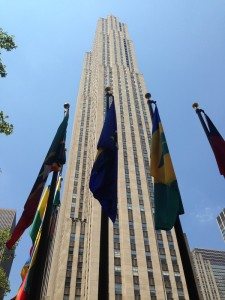
We may not work directly with the fine people at Rockefeller Center, but we certainly do our best to provide a similarly excellent experience at this wonderful landmark.
Join Free Tours By Foot on our Rockefeller Center Tour as we explore this beautiful complex inside and out, learning about its history and taking a closer look at the beautiful and intriguing artwork that permeates Rockefeller Center.
Our tour does not run in the winter, but we recommend taking along our self-guided version.
Sites we cover on the Rockefeller Center Tour:
- Radio City Music Hall
- Atlas Statue
- St. Patrick's Cathedral
- Channel Gardens
- Prometheus Statue
- NBC Studios/Today Show
- 30 Rock/Main lobby
**Seasonally**
- Ice skating rink
- Rockefeller Christmas Tree
See photos of the tour on our Facebook page and check out our self-guided Rockefeller Center Tour.
Tour information
Reservations: REQUIRED. Click here to reserve. For groups of 6 or more, please visit our group page before booking.
Where: 1250 Avenue of the Americas (6th Ave.) Look for your guide with the Free Tours by Foot logo on the East side of 6th Ave. between 49th and 50th Streets (map).
Duration: Approximately 1.5-2 hours. Tour distance is approximately 1.5 miles (2K)
When: @2pm Saturdays. Our tour is not available in the winter, though an amended version is included on our Midtown Manhattan Tour. Tours go out rain or shine. Dress appropriately for the weather.
If you can’t make one of our tours, you might consider one of the New York tourist passes, which include free guided tours of Greenwich Village.
Cost: This tour is free to take and you decide what, if anything, the tour was worth when it’s done.
A name-your-own-price tour is a tour for any budget. For more tips on saving money, check out our Guide to New York City on a Budget.
SELF-GUIDED TOUR OF ROCKEFELLER CENTER
If you want to save money while visiting Rockefeller Center, there is still plenty you can see and do without taking a tour.
With that in mind, we've created a self-guided tour that you can use to learn about the area.
Experience one of the most significant landmarks in NYC for free and find out what makes 30 Rock such an important gathering place for New Yorkers.
Start
A - 1250 Avenue of the Americas (6th Ave. between 49th and 50th St.)
Looking across the street to the west side of 6th Avenue, there are 4 very boxy rectangular skyscrapers that somewhat resemble the Rockefeller Center architecture.
They are an expansion of the center that was built in the 1960s.
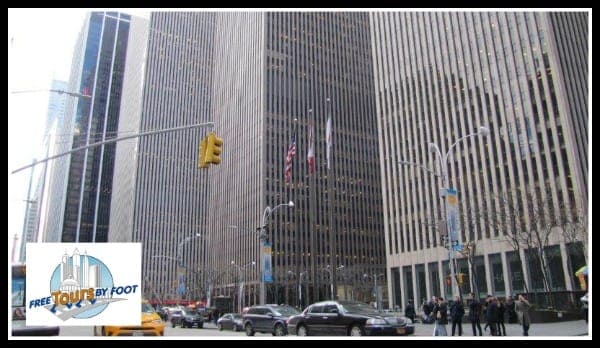
Heavily criticized as being boring and imposing, they don't quite reflect the beauty of the original center.
This is very much a media center in NYC which includes the Time/Life Building, McGraw Hill Publishing, and FoxNews.
However facing the entrance to 1250 we see the contrast in decorative style with a beautiful mosaic- "Intelligence Awakening Mankind" - by Barry Faulkner,
The mosaic is made of over a million tiny enameled tiles in 250 different colors. During WWI Faulkner had worked for the U.S. Army helping to design camouflage uniforms.
Walk 1/2 block north to 50th St.
B - Radio City Music Hall
This was the first building to open in Rockefeller Center in 1932 and at that time, was the largest indoor theater in the world with 6,200 seats in its audience.
It is known worldwide for its exquisite Art Deco interior, but also as being the home of the famous precision dance team, the Radio City Rockettes.
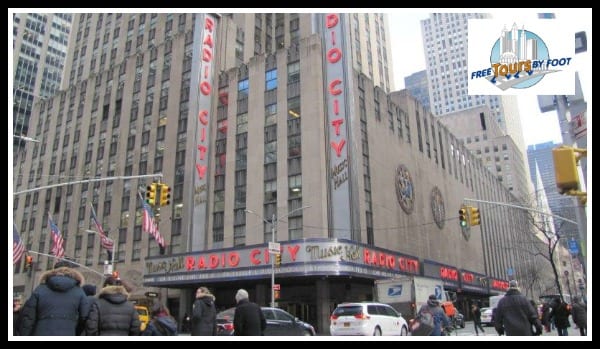
Originally, Radio City opened as a grand variety house that featured the famous Rockettes as well as symphonies, movies, newsreels, and a whole array of other entertainment.
Today it is still the largest and most famous theater in America and is primarily used for big-name concerts as well as other events such as the Tony Awards, the NFL draft picks, and of course the Radio City Christmas Spectacular featuring the Rockettes.
On the 50th St. side of the building are three round, painted metal sculptures representing "Dance, Drama & Song" by Hildreth Meiere.
Not only was it unusual for a woman to be among the acclaimed artists of the 1930s, but Meiere also contributed to the war effort during WWII helping the U.S. Army and Navy design maps for which she won an award.
Walk east on 50th St. towards 5th Ave. to the Top of The Rock entrance, south side of the street.
C - Top of The Rock lobby/Crystal Chandelier
Before you reach the main plaza pause for a moment to step inside the grand atrium at the entrance of Top of The Rock observation deck to see "Joie", a breathtaking 3 story cascading chandelier by artist Micheal Hammers.
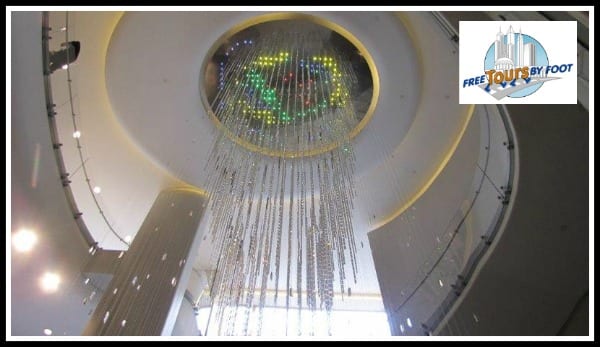
This elegant "waterfall" chandelier made up of 14,000 Swarovski crystals was installed in 2005 with the re-opening of the observation deck and resembles the outline of the skyscraper it is in - 30 Rock.
Swarovski is also the crystal design company that supplies the Rockefeller Christmas tree with its 550-pound star.
Continue towards 5th Ave to the main plaza and cross the street to the left, between 50th & 51st St.
D - The Bank of America Building
This building was originally built as the Associated Press Building and the entrance artwork reflects the building's original purpose. A giant stainless steel bas-relief by Isamu Noguchi named "News").
True to its name, it depicts five reporters "getting the scoop" using their tools of the trade; a camera, a telephone, a news ticker, a typewriter, and a notepad and pencil.
Another reminder of the advancement of humankind and American invention and ingenuity.
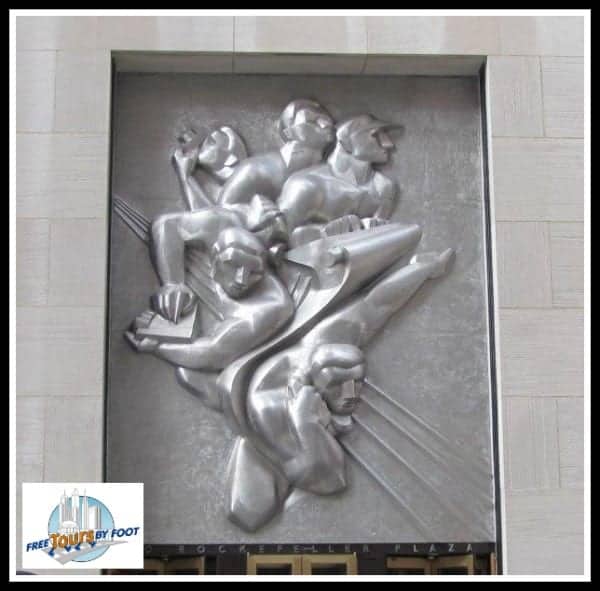
Opposite the BoA Building is the west side of the International Building.
On the 50th St. side of the exterior is a fascinating relief by Lee Lawrie, called "The Story of Man" (pictured above on the right). It alludes to the international nature of the building.
Since Rockefeller Center was built during the Great Depression it is well understood that the commercial complex would hope to draw international businesses as well as American ones, such as steamship companies, and the decorative International Building expresses that intention.

In this panel are Mercury, the Roman god of commerce and travel, figures representing art science, and industry, the four major "races" of mankind, and various regions of the earth depicted by the ocean and whale's fluke, palm trees, a mosque, and an Aztec temple.
Notice also that the trade ship in the middle is not only traveling from the "old world", symbolized by a castle and a lion, to the "new world", smokestacks, and an eagle, but also that it is facing towards the west.
Continue walking east towards 5th Ave. DON'T WORRY, we will be coming back to the main plaza later in the tour. At 5th Ave. make a left.
E - Atlas Statue
The largest and one of the center's most famous statues stands directly in front of the main entrance to the International Building and across 5th Ave. from St. Patrick's Cathedral and is also by Lee Lawrie whose artwork permeates the complex.
Atlas was a figure in Greek mythology who defied the Gods and was condemned to hold up the heavens on his shoulders for eternity.
In this incredible combination of ancient myth and modern style, the rings of the universe include the zodiacal signs of the constellations and above Atlas' shoulders are the symbols for the planets of our solar system.
Towards the top and to the north is a fleur-de-lis-shaped pointer directing to the North Star.
Mythological themes are prevalent in the decorative works of Rockefeller Center, again reminding us of the past while we continue striving for the future.
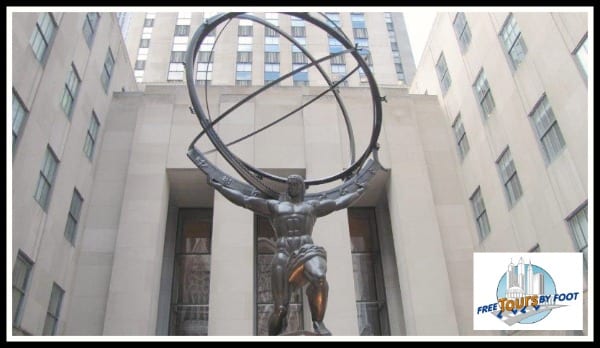
It also alludes to the idea that the complex's creators, if not mankind, were as great as the ancient Gods.
Take a moment to step inside the International Building lobby.
Interestingly the building was originally intended to be the Deutsche Haus as part of a complex of buildings dedicated to certain European countries.
Much of the steel within the International Building was manufactured in Germany during the early Nazi period.
However, the rapidly growing anti-German sentiment at that time resulted in a re-naming of the building.
Directly ahead and one level up and facing the entrance is a bust of Charles Lindbergh, considered a pioneer and a hero of that era (sometimes the stairway access to that level is roped off from the public, but the statue can be seen from the entrance level).
Lindbergh was the first person to pilot a solo trans-Atlantic flight in 1927, flying nonstop from Long Island, NY to Paris, France, alone in a single-engine airplane called "The Spirit of St. Louis".
Lindbergh at that time was a superstar and the embodiment of American achievement.
His historic flight was still fresh in the minds of the public and seemed at that time the perfect symbol of man's ability to conquer nature and achieve what no one once thought could be done.
The decoration along the walls of the lobby made of steel leaves suspended and dancing on long wires is called "Light and Movement", an art installation added in 1978.
When coming back out of the International Building be sure to take advantage of a postcard photo moment- with Atlas in the foreground and St. Patrick's Cathedral in the background.
It will likely convince you that no part of the complex's design was by accident or whimsical. Some have speculated that the placement of the giant mythological figure directly across from the cathedral was a show of defiance towards the Catholic Church.
Turn right and walk south across 50th St.
F - The British Empire Building/La Maison Francaise (G)
The two buildings on 5th Ave between 49th and 50th Street both offer intriguing decorations adorning their facades.
On the 50th St. side, the British Empire Building shows the British coat of arms, and human figures representing various trades of the Commonwealth.
The Sun over the door represents the British Empire itself, over which it was said for centuries that the sun would never set.
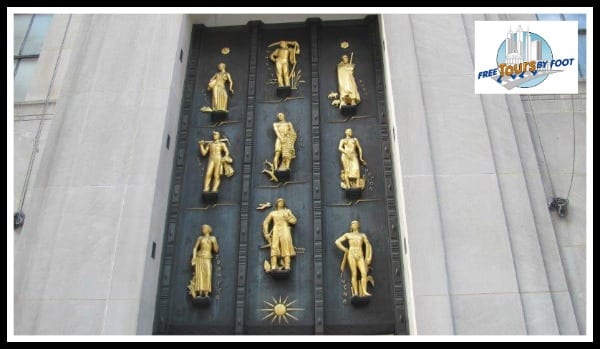
G - La Maison Francaise
La Maison Francaise, or "French Building", on the 49th St. side is adorned with a gold gilded relief depicting the cities of Paris and New York holding hands across the Atlantic Ocean.
Again, the scene evokes "old world - new world" imagery -and notice the terracotta relief above depicting an Art Deco version of a woman holding the torch of liberty.
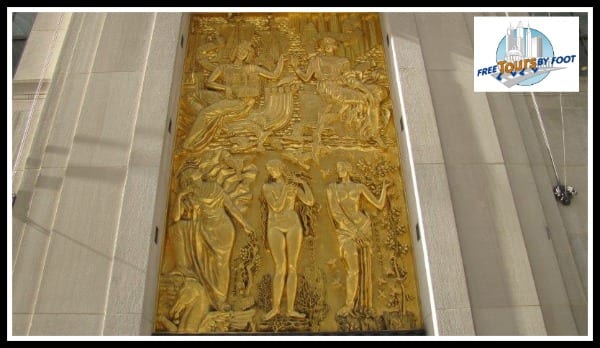
Walk back to the promenade in between the British and French buildings and turn left.
H - Channel Gardens
This promenade was given its name for the English Channel, the body of water that separates England and France.
It is decorated with seasonal floral displays, bronze statues and fountains of tritons and nereids riding dolphins and other fanciful sea creatures.
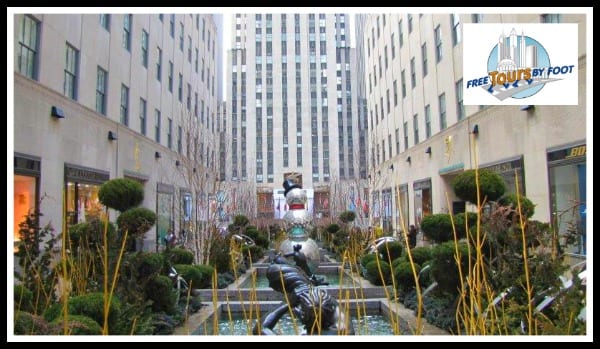
It was sculpted by Rene Chambellan. Be aware that these fountains are sometimes temporarily removed for seasonal decorations or special events.
The pedestrian promenade leads from 5th Ave towards the heart of the main plaza and is a great place for window shopping.
Walk straight ahead to the Lower Plaza
I- Lower Plaza/Prometheus Statue
Directly ahead is the tallest building and main centerpiece of Rockefeller Center, the GE Building, also known as 30 Rock.
In front of the main entrance are the Lower Plaza and the famed gilded statue of "Prometheus" by Paul Manship.
The Lower Plaza is where you'll find the city's most famous ice skating rink from October through March.
In the spring and summer, it serves as an outdoor cafe. Above the Lower Plaza is Prometheus, considered to be among the top four most famous statues in America.
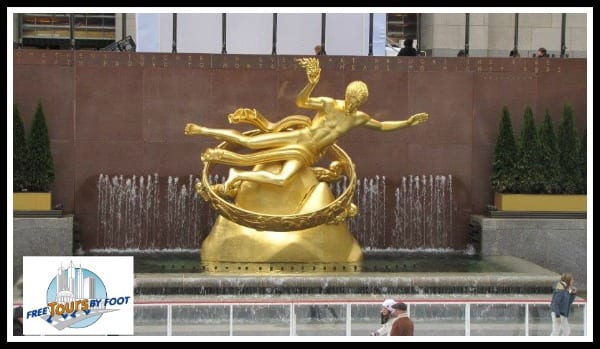
Prometheus was a Titan in Greek mythology who defied Zeus by giving mankind the gift of fire.
Here we see Prometheus descending from the heavens, as suggested by the astrological symbols surrounding him, with a ball of fire in his hand.
The backdrop for the statue at this viewpoint will depend on the season.
From late November to early January the world-famous Rockefeller Christmas Tree, one of NYC's most popular traditions stands directly behind Prometheus.
When it is not the holiday season, behind the statue you are looking directly at the main entrance to the GE Building adorned by a spectacular terracotta relief by Lee Lawrie.
The relief is called "Wisdom" (which is described in further detail at the end of this post).
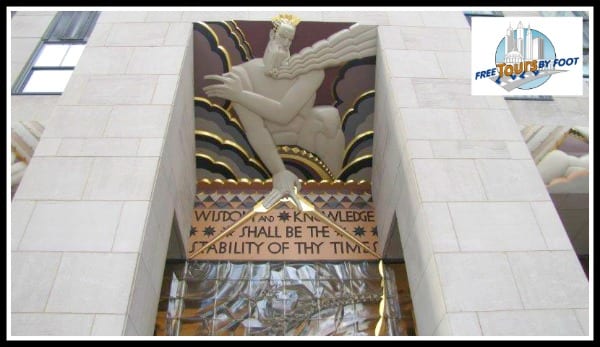
While standing near both these pieces of art, take a moment to look at them in relation to each other.
The two separate artworks together suggest a famous moment in ancient Greek mythology- Prometheus delivering the fire while being banished from Mt. Olympus by Zeus.
Walk to the left to 49th St. then right continuing towards the main plaza.
J - NBC Studios/Today Show
At the corner of the GE Building facing 49th St. and the plaza, you will easily see the NBC Experience Store.
This is where NBC's flagship studios are located in NYC and where many NBC TV shows are recorded including The Tonight Show with Jimmy Fallon, and Saturday Night Live.
Interestingly, this section was built independently and separately from the GE building, although it looks as though it's attached, to minimize vibrations within the television studios.
Across 49th St. is The Today Show studio - the "fishbowl" style of morning news that allows fans to crowd around the windows and wave to the cameras pointing outward while they broadcast live.
People arrive very early to be a part of the show every weekday morning from 7 am - 9 am.
The plaza next to the studio between 49th and 48th St. is where they host their free outdoor concerts on Friday mornings in the summer, often featuring big-name entertainers.
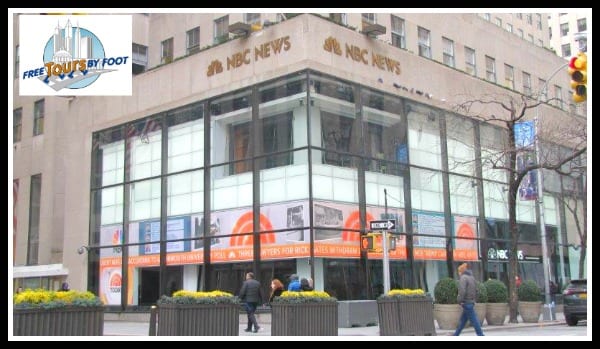
Next to The Today Show on the 49th St. side is Christie's, the world's most famous auction house.
If you like art you can take a brief detour here and stroll along the giant windows and view pieces from some of the most famous and renowned artists in the world. Then return to The Today Show studio.
Walk a few steps towards 48th St. and enter the lobby of 10 Rockefeller Plaza next to The Today Show.
K - Eastern Airlines Building
This building was originally intended to be the Dutch Building, again attempting to commemorate good trade relations with our European friends.
But like the Deutsche Haus, the events of WWII caused building planners to rename and repurpose the building when Germany invaded Holland.
It became the Eastern Airlines Building and its lobby is adorned with a striking panoramic mural in gold, silver, and deep brick red by Dean Cornwell.
This distinctive piece depicts the history of transportation from pioneering the wild frontier to taking the sky.
More themes are repeated here that represent the Art Deco tradition- combining classic and modern styles, ancient mythologies and looking toward the future.
Walk down the spiral staircase, then head towards the left, you will see signs directing you towards the restrooms. Yay!
L - Lower Concourse
Beyond the restrooms is the Lower Concourse of the GE Building.
Directly ahead you will be able to see through the glass walls to the outdoor Lower Plaza, whether ice skaters in the winter or diners enjoying being outside in the summer.
There is a sizable food court, plenty of shopping, and many delectable treats to be found in the Lower Concourse.
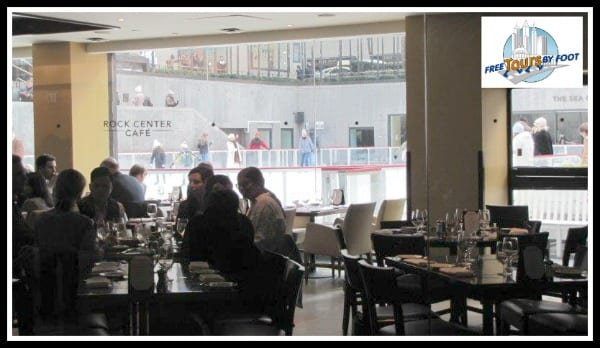
After the restrooms, there is a staircase and escalator on the left side. Go up one level to the main lobby.
M- 30 Rockefeller Center Lobby
Naturally, the main entrance to Rockefeller Center's centerpiece building reminds its visitors of the intentions and visions of the time with impossible-to-ignore murals and frescoes.
The surrounding artwork is by Spanish artist Jose Maria Sert who used powerful imagery to depict scenes of the past contrasted with images of industry, the path to a better future.
The mural directly behind the information desk opposite the entrance is called "American Progress" and includes the images of Abraham Lincoln- a man of action- and Ralph Waldo Emerson- a man of thought.
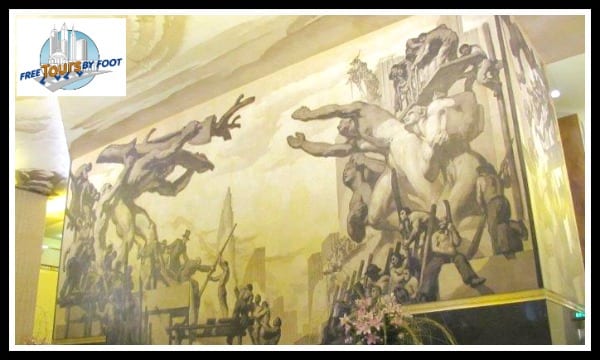
When looking critically at the works, one might think there were pretty bold artistic choices made for the 1930s (particularly if you look up), however, they pale in comparison to the controversial paintings that came before them.
The original lobby painting, "Man at Crossroads", was commissioned by the famous artist Diego Rivera, who was known to have had strong political feelings.
His final work differed somewhat from the original plan he submitted and was clearly anti-capitalist. It depicted scenes of protesters marching with red flags and even included a portrait of Lenin.
The Rockefeller Foundation would have kept the painting had Rivera been willing to paint over the more controversial portions.
But Rivera said he would rather see the painting destroyed than alter it. So Rivera got his wish.
Walk out of the main entrance to the plaza.
N - GE Building Entrance/Main Plaza
The main entrance to the GE Building lets out into the main plaza on the west side of the Lower Concourse/skating rink.
The perimeter of the rink is flanked by flagpoles and the flags flying around the concourse, like many other decorations around the center, will depend on the day or season.
Usually, you will see the flags of all the countries that are members of the United Nations.
Sometimes instead the state flags of the U.S. are flying.
On patriotic holidays such as July 4th, the plaza flies only American flags, and during the Christmas season, the flags are all shimmering gold, silver, red and green.
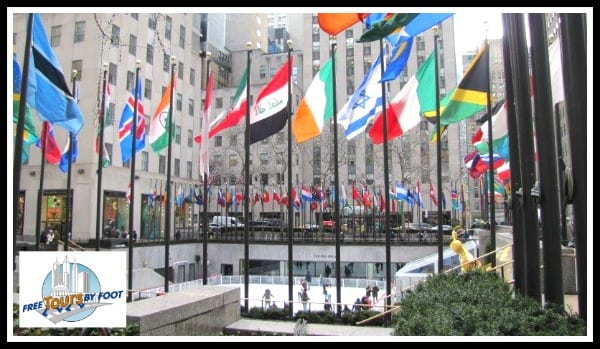
Directly ahead of the entrance several paces forward and embedded in the pavement is a large, round, bronze placard marking the spot of the famous Rockefeller Christmas tree - a tradition that started with the construction workers themselves in 1931.
Before any building in Rockefeller Center was open the workers pitched in and bought and set up their own tree on that spot while working hard through the holiday season.
The first official public tree with electric lights was presented, along with the first Radio City Christmas Spectacular show, in 1933 and both have grown to become known around the world as some of NYC's best-known traditions and attractions.
Turning around towards the GE Building faces you towards the heart of Rockefeller Center.
The building was originally built as the RKO Building as its original intention has always been to broadcast radio and television.
In later years RKO was bought by GE and the building was renamed. However, it continued its purpose as the home of NBC Studios.
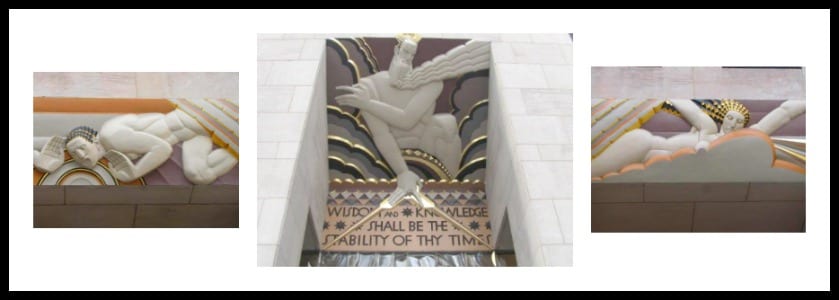
And once again the building's design makes a point of expressing its function through art. The impressive and commanding bas-relief above the entrance by Lee Lawrie depicts the figure of
"Wisdom" spreads a compass over a beautiful glass screen made from 240 blocks of glass from the esteemed Corning Co., and is flanked on either side by figures representing the "Cycle of Light" and the "Cycle of Sound".
These ideas were certainly the themes and the ideas behind Rockefeller Center from its inception, and how the center from the beginning of its construction gained the nickname "Radio City".
We hope you loved your self-guided tour of Rockefeller Center and as you continue to explore the complex can now notice and enjoy the clues around you as to the vision of its creators!
Tips from Locals and Travelers
To give you more feedback, we asked the 225k members of our NYC Travel Tips Facebook Group what they thought of the Rockefeller Center tour.
Below are just a handful of comments, but many more members love going to Rockefeller Center. It’s one of the most popular attractions in NYC!
Locals and visitors to NYC alike loved the official tour as well as the self-guided tour option.

Elissa took the tour when she was a child yet still remembers it because it left a positive impression on her. As an adult, she and her kids loved the Radio City Music Hall tour!

If you want to learn what other locals and visitors have to say about other NYC attractions and activities take a look at our NYC Travel Tips Facebook group!






